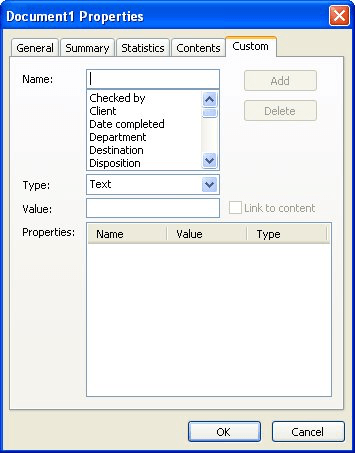Please Note: This article is written for users of the following Microsoft Word versions: 97, 2000, 2002, and 2003. If you are using a later version (Word 2007 or later), this tip may not work for you. For a version of this tip written specifically for later versions of Word, click here: Using Document Properties to Ensure Consistent References.
Written by Allen Wyatt (last updated December 3, 2022)
This tip applies to Word 97, 2000, 2002, and 2003
There are many times when you are putting together a document that you need to make sure that certain references are consistent. For instance, you may need to refer to a particular person's name or a company name, and it is imperative that the references be precise and accurate throughout the document.
There are several ways you can handle this situation using Word. One rather unique way is through the use of document properties. You probably already know that Word maintains a series of properties for your documents. These properties include things such as the size of the document, the last time it was updated, and the like. You can also define custom properties that act like variables for your document. To define a custom property, follow these steps:

Figure 1. The Custom tab of the Properties dialog box.
Now you are ready to use the new document property within your document. You do this in this manner:
When you display the field results, Word fetches the contents of your custom document property and displays it in place of the field. If you change the value assigned to the document property and then update the fields in the document, all instances of the reference are updated.
WordTips is your source for cost-effective Microsoft Word training. (Microsoft Word is the most popular word processing software in the world.) This tip (224) applies to Microsoft Word 97, 2000, 2002, and 2003. You can find a version of this tip for the ribbon interface of Word (Word 2007 and later) here: Using Document Properties to Ensure Consistent References.

Learning Made Easy! Quickly teach yourself how to format, publish, and share your content using Word 2013. With Step by Step, you set the pace, building and practicing the skills you need, just when you need them! Check out Microsoft Word 2013 Step by Step today!
Headings form the outline of your document and hopefully give it an easy-to-follow organization. If you want to share ...
Discover MoreThe no-width optional break is primarily used for Asian languages in Word. It can have value for English-speakers, as ...
Discover MoreNon-breaking hyphens can come in helpful for some types of writing. They force the words (or characters) on both sides of ...
Discover MoreFREE SERVICE: Get tips like this every week in WordTips, a free productivity newsletter. Enter your address and click "Subscribe."
There are currently no comments for this tip. (Be the first to leave your comment—just use the simple form above!)
Got a version of Word that uses the menu interface (Word 97, Word 2000, Word 2002, or Word 2003)? This site is for you! If you use a later version of Word, visit our WordTips site focusing on the ribbon interface.
Visit the WordTips channel on YouTube
FREE SERVICE: Get tips like this every week in WordTips, a free productivity newsletter. Enter your address and click "Subscribe."
Copyright © 2024 Sharon Parq Associates, Inc.
Comments